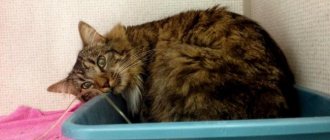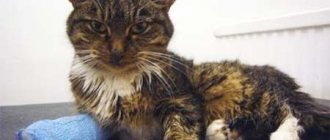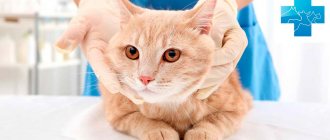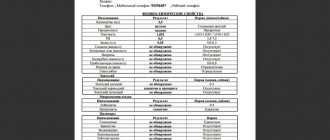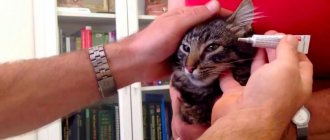Each organ in the body of a living creature fulfills its role assigned by nature. Health and life expectancy depend on how well all organs work. Although they say that a cat has 9 lives, we will look realistically at the problems and diseases that this animal faces. Let's talk today about what kidney failure is in cats , what causes it, what are its symptoms and how fight it.
This topic is very important! After all, if you don’t start treatment on time or change your pet’s diet, the outcome can be fatal.
. Timely help from veterinarians will relieve kidney failure. Cats will no longer have kidney problems, and their owners will have no reason to worry about the life of their pets.
Renal failure and its etiology
Common causes of poor kidney function in cats include:
- infections, bacteria penetrating the kidneys through the urethra, or from adjacent organs and tissues;
- frequent inflammatory processes;
- unilateral hypoplasia (underdevelopment of one kidney and its failure in old age);
- incorrect, ineffective or interrupted treatment;
- toxic effect on the kidneys (poisoning);
- autoimmune glomerulonephritis;
- tumors of various origins.
Some cat breeds are genetically predisposed to kidney failure. These include Persians (exotics), who are often diagnosed with polycystic disease. Because of this, the pet’s lifespan is reduced by 1/3, there are problems with bearing and giving birth to kittens, or with concomitant diseases of the urinary system, cats die before reaching 5-8 years of age.
It is important to know! Polycystic disease is a genetically inherited pathology, it occurs even in kittens, mixed breeds and Persians. Infantile polycystic disease most often occurs in mixed-breed and Persian pets and is diagnosed after 10-12 years of age. Therefore, cats that show signs of the disease are sterilized and are not bred.
Causes
Kidney failure occurs for a variety of reasons:
- frequent renal inflammatory processes;
- past infectious diseases;
- some immune diseases;
- any types of poisoning;
- congenital defects and disorders of the kidneys;
- stones or tumors in the kidneys or urinary system;
- injuries.
Most often, kidney failure occurs in older pets, aged 8-9 years. The aging process begins, and the kidneys cease to fulfill their filtering role. In young kittens, the disease may be due to heredity or genetic disorders. Sometimes deficiency can be due to the fault of the owner: the diet includes low-quality food, the pet does not have access to water, or an infectious disease is not cured in time.
Persian and Abyssinian cats suffer from kidney failure more often than other breeds.
Classic signs of dysfunction of a paired organ
There are 2 forms of renal failure - acute renal failure and chronic renal failure, that is, acute and chronic manifestations of the pathology. Their symptoms differ significantly, but there are a number of signs that are common in their manifestation:
- age after 8 years (the breeder mistakes the initial signs of renal failure for old age and natural physiological changes);
- decreased activity;
- ammonia odor from the mouth, drooling;
- the cat drinks a lot and pees (8-10 approaches to the tray), due to the copious amount of urine, the perineum and fur get wet;
- there is no appetite, the pet is losing weight before our eyes, the ribs can be felt;
- pale mucous membranes and swelling on the paws and chest, extending to the chest and abdominal cavities.
When the kidneys are damaged, body temperature begins to fluctuate both upward (hyperthermia) and downward (hypothermia). The cat looks unkempt, its fur is dull and unkempt.
When the disease progresses into critical ranges, signs of severe kidney damage appear. The cat will be lethargic, with symptoms of severe dehydration, virtually no urination, and vomiting (often with blood). Defecation ranges from diarrhea to constipation, bloody diarrhea. Damage to the central nervous system is manifested by convulsions and tics.
Symptoms of chronic renal failure
Even if your cat is on a diet, medication, and fluid therapy, at least some of the symptoms listed below will eventually begin to appear.
Not all cats will show all the symptoms:
- Excessive urination
- Increased thirst
- Nausea and vomiting
- Licking lips
- Grinding or cracking in the jaw
- Vomiting (clear or foamy liquid and food)
- Salivation
- Dehydration
- The cat sits hunched over a bowl of water
- Loss of appetite
- Weight loss
- Loss of muscle mass
- Exhaustion
- Hair loss
- Bad breath (ammonia smell)
- Lethargy
- Sensitivity to sound
- Eating litter from a tray
- Weakness
- Depression
- Mouth ulcers
- Retinal detachment
- Convulsions, low body temperature, and coma may also occur.
ESRD has no cure, but the condition can be managed for a period of time. The basis of the management of chronic renal failure is to control the amount of metabolic products passing through the kidneys. Since the ability of the remaining nephrons to clear waste products from the body is limited, the idea is to reduce the amount of these products to a level that the nephrons can handle. This effect is achieved through a combination of diet, medications and hydration therapy (diuresis).
Research is currently underway to slow the progression of chronic renal failure using ACE inhibitors and calcium channel blockers. These drugs dilate blood vessels, thereby lowering blood pressure and improving circulation without harming the kidneys. Kidney transplantation and dialysis are also already possible. Kidney transplantation should not be considered as a cure, but as an option for the treatment of chronic kidney disease in a cat. However, the experience of carrying out such operations in domestic veterinary medicine has not been successful.
Acute renal failure
It is classified into three types, it all depends on the stage at which the change in the functions of the organ occurred. With prerenal insufficiency, there is a decrease in the volume of blood circulating through the kidneys, while the organ itself does not undergo changes or injury. The causes are all conditions in which a sharp drop in pressure in the blood vessels occurs: shock, heat stroke, cardiovascular failure, heavy blood loss, etc.
In case of renal failure, damage directly to the kidney structures occurs due to the action of viruses, infections, drug intoxication, poisoning, DIC syndrome, etc. Depending on the strength of the damaging factor, the pathology is reversible or irreversible, but, in any case, complete recovery kidney function is impossible.
Postrenal failure does not end with the complete breakdown of organ tissue, but occurs when the perinephric excretory structures are damaged - the bladder, ureters, and urethra. The history includes abdominal injuries, urinary tract infections, and neoplasms.
Diet for the treatment of chronic renal failure
Following a diet for chronic renal failure is an important stage of treatment and is subsequently required to maintain the health of the cat and prolong its life. Since irreversible changes occur in the kidneys during chronic renal failure, the animal urgently needs a specialized diet.
After detoxification has been carried out, blood pressure and electrolyte balance have been adjusted, the protein load on the kidneys should be reduced, since in the chronic course of the disease they cannot cope with the removal of protein breakdown products. To maintain the correct dietary intake, veterinarians advise giving the animal medicinal foods of the kidney series, "Khlis", "Purina" and "Ekanuba".
CRF and its forms
The development of the chronic form of renal failure occurs over a long period of time and is almost imperceptible to the owner, but processes take place inside that affect the nephrons and replace them with connective tissue. As a result, the kidneys are deformed, many scars are formed, and functions are not performed. CRF is more often diagnosed in older cats.
The following forms of chronic renal failure are encountered in practice:
- latent:
- initial;
- conservative;
- terminal.
In the latter case, kidney failure occurs, coupled with insufficient functioning of other organs and tissues. The levels of urea and creatinine in the blood are off the charts; without treatment and hemodialysis, the cat dies in 100% of cases.
It is important to know! The breeder notices the symptoms of chronic renal failure only when over 60% of the nephrons are affected. Until this moment, the cat owner either does not notice a slight malaise, weight loss or a change in urination, or ignores it.
Forecast
The biggest problem in treating chronic kidney disease is that owners only notice changes in the animal's condition in the later stages of renal tissue degeneration. It usually takes some time before the owner decides to take the cat to the doctor. As long as at least 30% of the nephrons retain functional activity, the animal appears healthy. And when signs of the disease appear, the process is irreversible. Therefore, it is possible to successfully control chronic renal failure only if it is detected during a biochemical blood test in the early stages. Unfortunately, annual medical examination of animals has not yet become a common procedure in our country. Few owners realize that many animal problems could be avoided through annual examinations and solving problems in the early stages.
Since 99.9% of cats are admitted in a state of decompensation, when the body can no longer cope with the consequences of impaired renal function.
At stages 1 and 2 of the disease, the prognosis is cautious. In stages 3 and 4 - unfavorable. In each specific case, it is always difficult to give an accurate prognosis to the animal owner, since histological examination is extremely rare and the doctor can only determine the condition of the kidney tissue by indirect signs. Sometimes a cat with a creatinine of more than 800 µmol/l after a course of infusion therapy shows positive dynamics and feels good for a long time on a therapeutic diet. And in other cases, with a creatinine level of 300–400 µmol/l, the animal does not respond to therapy and dies.
You should always weigh your options carefully. The course of treatment may last a week or more. Requires investment of time and money. And there is no guarantee that the animal will recover. In such a situation, each owner makes a choice based on his life principles and capabilities.
Diagnosis of kidney failure
It is a mistaken belief of the breeder that a veterinarian can make a diagnosis just by looking at the animal. Based on external signs, if they are pronounced, one can only form a preliminary opinion, but the final diagnosis requires laboratory confirmation.
Required:
- history taking, examination;
- blood and urine tests;
- Ultrasound of the abdominal organs and kidneys;
- X-ray.
It is important to understand that the diagnosis of chronic renal failure is made only after receiving laboratory test results!
Difference between acute renal failure and chronic renal failure
In 90% of cases, cats arrive at the RosVet EC already at the chronic stage. But during exacerbation, the two forms can be confused. Therefore, you should know the signs that distinguish a truly acute form of renal failure from a chronic one in the acute stage:
- There is no anemia with acute renal failure, it does not have time to develop;
- CRF develops smoothly and lasts a long time; the animal is often admitted to the clinic with an unfavorable prognosis;
- With acute renal failure, the kidneys are very painful.
Diagnostics in a veterinary clinic
To confirm the disease and determine its form, the veterinarian examines the patient with a mustache, collects anamnesis and conducts diagnostic tests. The mandatory list includes:
- Analysis of urine
. The diagnosis is confirmed by elevated levels of protein and blood cells. The color of the discharge changes to black or almost transparent. The density of urine decreases and sediment appears. The pH level shifts towards an acidic environment.
- Blood analysis
. The amount of glucose, leukocytes, creatinine and phosphates deviates upward. Lymphocytes, hematocrit, platelets and hemoglobin fall. In chronic renal failure, severe anemia is diagnosed.
- Ultrasound
. The examination shows changes in contour and size, as well as the formation of cysts or other neoplasms.
- X-ray
. Determines the area and extent of damage.
A cat with acute renal failure tolerates palpation painfully. Her kidneys are enlarged and her bladder is full of urine. When the urinary organs rupture, free fluid may enter the peritoneum or subcutaneous tissue.
CRF is confirmed by a noticeable softening of the facial bones, which are left without the required amount of calcium. Ulcers may appear on the tongue.
Prevention and treatment
It is impossible to prevent kidney failure, especially in the case of a genetic predisposition. The only thing the owner can do is to show the cat to a veterinarian 2-3 times a year. Timely detection of kidney pathologies and internal diseases leading to PN is the key to the animal’s life. It is also necessary to prevent factors (stress, poisoning, etc.) that can lead to kidney failure.
Treatment is symptomatic and consists of stabilizing the cat’s condition, eliminating primary diseases and maintaining kidney function. Dead nephrons are not restored; the sooner the breeder shows the animal to the veterinarian at the RosVet VC, the higher the chance of stopping pathologies that destroy the kidneys.
If you notice that your cat is showing signs of acute renal failure or chronic renal failure, she is at risk for polycystic disease - do not hesitate! Call the RosVet VC by phone, 24 hours a day. The clinic is open 24 hours a day.
This disease has stages and substages
IRIS classification of kidney diseases:
Stage 1 (non-azotemic chronic renal failure):
Normal creatinine (less than 140 µmol/L), but there are other abnormalities suggestive of renal failure (eg, renomegaly, proteinuria, poor urinary concentrating ability.)
Stage 2 (weak chronic renal failure):
Creatinine is above 140-250 µmol/l. This lower level of about 140 mmol/L may be within the normalized range.
Stage 3 (moderate chronic renal failure):
Plasma creatinine 251-439 µmol/l.
Stage 4 (severe chronic renal failure):
Cats in this stage of CRF have creatinine levels greater than 440 µmol/L.
Substages of chronic renal failure:
- Non-proteinuric less than 0.2 protein
- Borderline proteinuric 0.2–0.4
- Proteinuric acid more than 0.4
Diagnostic tests
An accurate diagnosis can only be made in a hospital setting, using laboratory and instrumental methods:
- Biochemistry of blood. The analysis determines the level of urea, potassium, creatinine, sodium, calcium, chlorine, magnesium, cfc.
- Ultrasound examination of the organ. It will show its shape, structure, location, and the presence of cysts. Kidney ultrasound is one of the most informative methods for diagnosing the disease.
- X-ray using contrast agent. Used to evaluate affected areas of the kidneys.
- General urine analysis. Shows the presence of bacteria and renal epithelium in urine, determines the level of leukocytes.
Computed tomography of the kidneys is considered the most accurate diagnostic method, but due to the high cost of analysis, this method is practically not used.
Stabilization of the patient's condition
The patient's recovery may take from several days to several months. The improvement is characterized by a decrease in blood creatinine/urea levels and normalization of the acid-base balance. Hospitalization of the patient is indicated until there is a persistent decrease/normalization of renal parameters within 3-5 days.
The prognosis depends on how quickly treatment was started, how quickly diuresis was restored, and what concomitant pathologies are observed in your pet.
(c) Veterinary center for the treatment and rehabilitation of animals “Zoostatus”. Varshavskoe highway, 125 building 1. tel. 8 (499) 372-27-37
Preventive actions
It is best to prevent the development of chronic renal failure than to then undergo complex and not always effective treatment for this disease. By following the recommendations below, the cat owner will be able to minimize the risk of disease:
- safety precautions must be observed. The cat must be protected from injury, poisoning and self-medication of various diseases must be avoided;
- when diagnosing urolithiasis, the animal must be treated exclusively in the clinic;
- infectious diseases of the urinary system should be diagnosed and treated in a timely manner;
- It is necessary to ensure that your pet does not gain excess weight.
You must also strictly adhere to the doctor’s recommendations if the animal is diabetic, since diabetes can cause the development of chronic renal failure.
